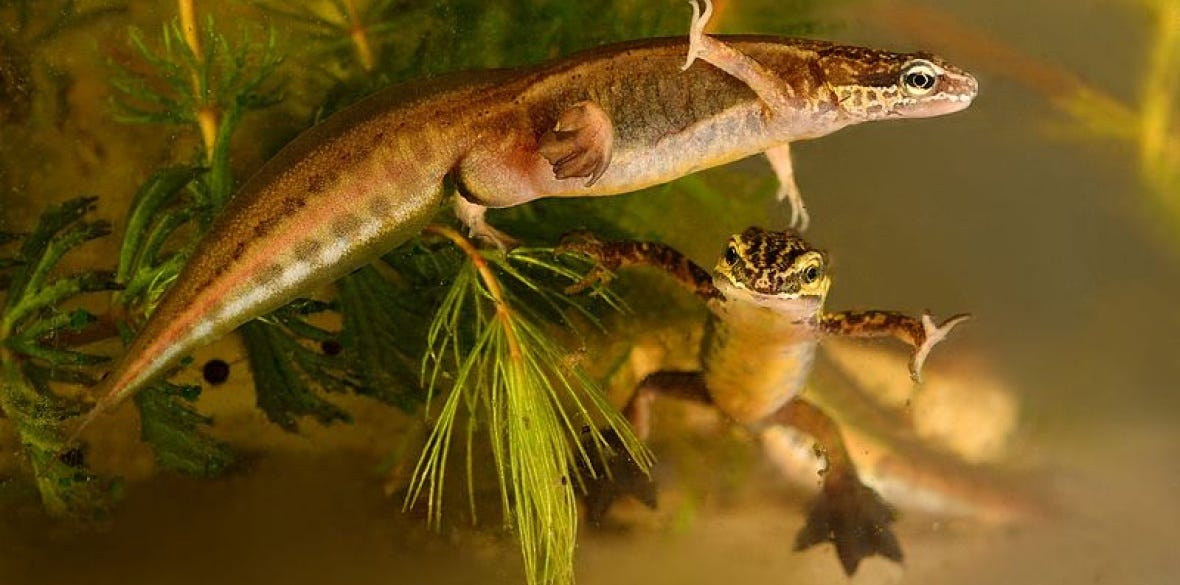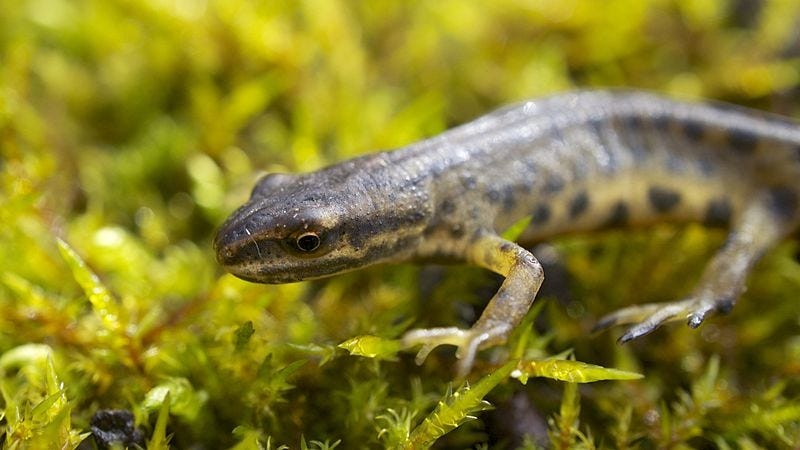The Courtship Display of Newts
Imogen dives underwater to look at how and when our native newts mate and lay eggs in the uk
Newts, which belong to the family Salamandridae, are an integral component of the Scottish uplands ecosystem.
With the arrival of spring, Highland newts are stirring from their winter dormancy, emerging from the damp crevices and burrows, where they have been conserving energy to survive the cold.
The warming temperatures trigger a hormonal surge, prompting the newts to migrate towards breeding ponds, where they will mate into June or sometimes as late as July - depending on the species and conditions.
Mating Rituals and Life Cycle
The mating rituals of newts are a sight to behold. Both male Smooth Newts and male Great Crested Newt have similar a vibrant courtship display, using their tails and flashing their bellies in what is akin to an underwater flamenco. However the entire process is actually quite precise.
The initial phase of the ritual sees the male positioning himself before a female, endeavouring to capture her interest. Often, the female may simply swim away, however - if the male is successful in grabbing her attention he will proceed into a display- vigorously fanning his tail. This tail action serves a dual function as it directs his pheromones towards her. As she becomes mesmerised by this - she now starts to follow him.
The male will then pause and the female touches her nose to his tail. This is the signal for him to deposit his spermatophore, he then allows her the space to position her cloaca directly above it. Correct placement is crucial for successful fertilisation (as the female absorbs the spermatophore into her body). If the spermatophore uptake fails, the male must start his courtship display anew, hoping for a better outcome.
In this wonderful underwater footage you will seen these courtship displays in action as the male pursues the female starting at 2 minutes in.
The wonderful and intricate dance of attraction highlights the complex behaviours and rituals that govern the reproductive strategies of newt in our locale.
The Female Lays her Eggs
Upon successful courtship, females lay their eggs on underwater vegetation, attaching them with a sticky substance. The choice of location is crucial, as it provides protection from predators and suitable conditions for development.
Female newts will lay each egg individually on its own leaf before wrapping it up (using their hind legs). This protects the eggs from predators until they are ready to hatch. They will lay up 200+ eggs in this way, over the course of the season.
As the eggs hatch this summer, our Highland ponds will become nurseries for young newts.
The Importance of Wetlands
Ponds play a pivotal role in the newts' life cycle, serving as breeding grounds and shelter during their aquatic stages. In recent years, there has been growing concern over the conservation of these fragile ecosystems. Preservation efforts are crucial to ensure the survival of not only newts but also a myriad of other species that call these habitats home.
Habitat loss due to human development and agricultural activities threatens the newts' survival. Pollution, including agricultural runoff and chemical contamination, can harm both newts and their prey.
However, their adaptability and resilience have allowed them to persist in this challenging environment.
The High Life Highland Ranger service aim to educate and inform and restore some newt habitats throughout 2024 on our theme of the year - so continue to watch this space for upcoming news on our exciting and ever developing Puddles to Ponds project.
Imogen Furlong, the High Life Highland Countryside Ranger Manager, is known for her enthusiasm, organisation, and drive. Her deep passion for the Scottish Highlands' wildlife and extensive experience in outdoor education and recreation management have been central to this role. Imogen is a practical and collaborative project manager, empowering her teams to work effectively in communities and contribute to local conservation efforts.
The Scottish Highlands are home to several species of newts:
1. Common Newt / Smooth Newt (Lissotriton vulgaris):
Also known as the smooth newt. It can be found in a variety of aquatic habitats, including ponds, lochs, and slow-flowing burns.
2. Palmate Newt (Lissotriton helveticus):
The palmate newt is the most common newt species in the region. It tends to favour smaller ponds, ditches, and shallow water bodies with ample vegetation.
3. Great Crested Newt (Triturus cristatus):
This species is the largest of the newts found in the Scottish Highlands. Great crested newts are characterised by their distinctive warty skin and a jagged crest along the male's back during the breeding season. They are often associated with larger bodies of water, such as deeper ponds and lochs.










Great info and learning for a Monday morning! Also took me back down memory lane looking for newts when I was a kid! I look forward to getting these newsletters.